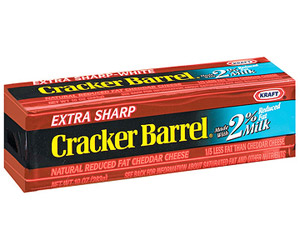 Cracker Barrel Trademark Battle
Cracker Barrel Trademark Battle
Kraft Foods and Cracker Barrel Old Country Store are in a heated legal battle over the rights to the trademark CRACKER BARREL. This case is interesting not only because of the fame and reach of both companies, but also because the parties have been using variations of the “Cracker Barrel” name since the 1940s (in the case of Kraft Foods’ “Cracker Barrel Cheese”) and the 1960s (in the case of the Cracker Barrel restaurants). While it’s common for identical marks to be used in connection with separate types of goods and services, this case illustrates the dangers when one party’s’ lines of business start to encroach on the other’s rights.
For the purpose of clarity, I’ll refer to the restaurant chain as “CBOCS.”
Kraft Foods has been selling cheese under the brand name CRACKER BARREL since 1948. They have had a trademark registration with the United States Patent and Trademark Office for the mark CRACKER BARREL since 1957. (I see that their USPTO application was filed in 1950, but the registration didn’t issue until 1957. And I thought the USPTO was slow nowadays…)
Kraft sued CBOCS in Federal Court (link goes to a PDF of the Complaint) after CBOCS announced that it planned to start selling CRACKER BARREL branded food products in supermarkets and other retail outlets. CBOCS has been selling CRACKER BARREL products in its restaurants, website, and in catalogs for many years. Apparently Kraft did not object to this use of the mark.
CBOCS’ first trademark registration for “Restaurant and Gift Shop Services” dates back to 1980. They also have registrations for food items, such as this one for apple butter, Maple syrup, buttermilk pancake mix, corn muffin mix, regular and decaffinated coffee, and apple crisp mix. That registration was issued in 2008, citing use of the mark on those items dating back to 1987. Kraft does not appear to have objected to that USPTO application.
In the current Complaint, Kraft stated that “In essence, CBOCS maintained a distance from Kraft both with respect to goods sold and channels of trade used.” This suggests that Kraft and CBOCS had some sort of agreement – spoken or unspoken – not to interfere with each other’s business. Or perhaps Kraft is seeking credit for acting in good faith in not opposing CBOCS’ prior trademark applications.
In any case, the parties are now in direct conflict. Despite the lawsuit, CBOCS has proceeded with its plans to sell its branded food products in supermarkets and elsewhere. Kraft is asking the court to stop this plan from proceeding and to invalidate an agreement between CBOCS and its licensing partner. CBOCS has countersued.
Is it possible that the court will find that Kraft is barred from enforcing whatever rights it has against CBOCS? The legal theory of laches may apply here – a defense which requires the defending party to prove that:
- the plaintiff unreasonably delayed in enforcing its rights; and
- the delay caused prejudice to the defendant.
(Citing New Directions for Laches Defence.)
…0r does CBOCS’ expanded business plan obviate any claim that Kraft had to enforce their rights at an earlier time in order to avoid prejudicing CBOCS?
It will be interesting to see how this case unfolds. The takeaway for any business with a brand name that is or might be similar to one held by another business: be very careful when you’re expanding your product or service lines that you are not potentially bringing yourself into conflict with another party’s trademark rights. As in most cases, one would think that the parties could have simply worked something out where they would mutually benefit. Unfortunately, the business world often doesn’t work that way.

